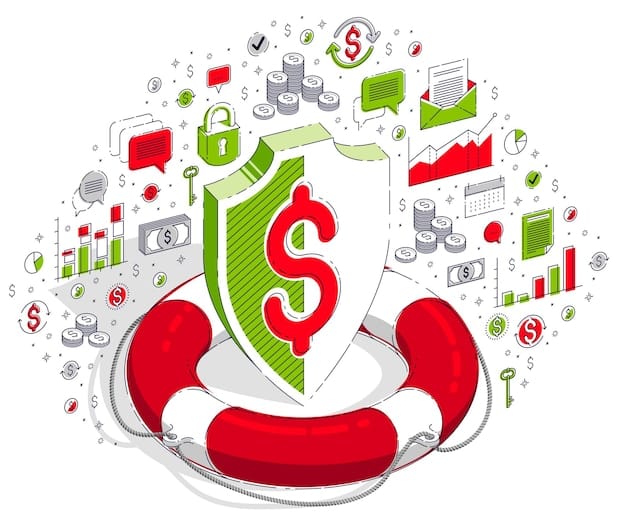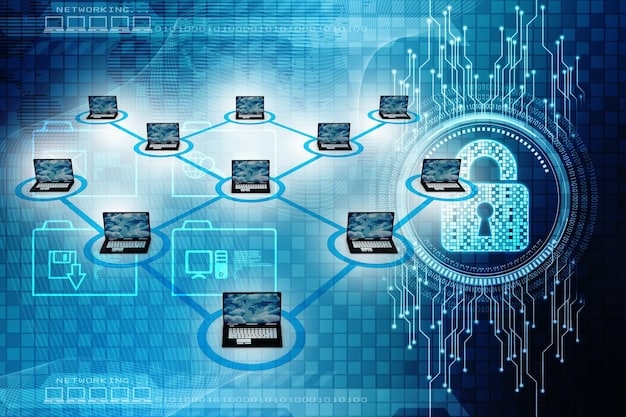Crisis Management: Prepare Your Business for Unexpected Challenges

Effective crisis management involves proactive planning, robust communication strategies, and continuous adaptation to mitigate risks and ensure business continuity when unforeseen events threaten operational stability and reputation.
In a dynamic business landscape, the adage “expect the unexpected” has never been more relevant. Navigating unforeseen disruptions requires a strategic and resilient approach. This article delves into the critical aspects of Crisis Management: How to Prepare Your Business for the Unexpected, providing actionable insights for safeguarding your enterprise against a myriad of potential challenges.
Understanding the Landscape of Business Crises
Every business, regardless of size or industry, operates within an intricate web of potential threats. These can range from natural disasters and technological failures to reputational damage and financial downturns. A profound understanding of this multifaceted crisis landscape is the foundational step in developing an effective crisis management plan.
Ignoring these potential pitfalls is not an option; instead, businesses must cultivate a proactive mindset. This involves not only identifying potential threats but also evaluating their likelihood and potential impact. Such an assessment forms the bedrock upon which all subsequent crisis preparedness efforts are built.
Defining Different Types of Crises
Crises manifest in various forms, each demanding a tailored response. Broadly, they can be categorized to facilitate a clearer understanding and more targeted preparation.
- Natural Disasters: Earthquakes, floods, hurricanes, wildfires.
- Technological Failures: System outages, data breaches, cyberattacks.
- Financial Crises: Market crashes, liquidity issues, bankruptcy.
- Human-made Disasters: Terrorism, industrial accidents, product recalls.
- Reputational Damage: Negative press, social media backlash, ethical scandals.
- Health Crises: Pandemics, widespread illness affecting staff or customers.
Each category presents unique challenges, requiring specific protocols and resource allocation. For instance, a data breach necessitates rapid containment and notification, while a natural disaster demands evacuation plans and business continuity protocols.
The Ripple Effect of a Crisis
A crisis rarely impacts just one area of a business. Instead, it creates a ripple effect, often disrupting operations, finances, reputation, and employee morale simultaneously. A supply chain disruption, for example, can lead to production halts, lost revenue, customer dissatisfaction, and even legal liabilities.
The interconnectedness of modern businesses means that a crisis in one department or region can quickly escalate and affect the entire organization. Therefore, a holistic approach to crisis management is essential, considering all potential downstream impacts.
Understanding the diverse types of crises and their potential cascade effects is crucial. It allows businesses to move beyond a reactive stance towards a more predictive and preventative strategy, laying the groundwork for resilience in the face of adversity.
Developing a Robust Crisis Management Plan
The cornerstone of effective crisis management is a meticulously crafted plan. This isn’t merely a document; it’s a living framework that guides an organization through turbulent times. A well-developed plan ensures that every team member understands their role, resources are readily available, and communication lines remain open and clear.
The process of creating such a plan demands collaboration across all departments, from leadership to frontline staff. It’s about anticipating every plausible scenario and formulating precise responses to minimize damage and accelerate recovery. This requires a strong commitment from the leadership team, ensuring resources and time are dedicated to proactive planning.
Key Components of a Comprehensive Plan
A truly effective crisis management plan comprises several critical elements, each designed to address a specific facet of a crisis.
- Risk Assessment and Prioritization: Identify potential threats and evaluate their likelihood and impact.
- Crisis Communication Strategy: Define spokespersons, communication channels, and messaging for internal and external stakeholders.
- Emergency Response Protocols: Outline immediate actions for various scenarios, including evacuation, first aid, and security measures.
- Business Continuity Plan: Detail procedures for maintaining essential operations during and after a crisis.
- Data Backup and Recovery: Ensure critical data is protected and recoverable to prevent loss of information.
- Training and Drills: Regularly practice the plan to familiarize employees with procedures and identify weaknesses.
Each component must be thoroughly developed, cross-referenced, and accessible to relevant personnel. For instance, the communication strategy should include pre-approved statements for different crisis types, ready for immediate deployment.
Building a Dedicated Crisis Team
A crisis management plan is only as good as the team implementing it. A dedicated crisis team, comprising individuals with diverse expertise, is vital for rapid and effective response.
- Team Leader: Often a senior executive, responsible for overall coordination and decision-making.
- Communication Lead: Manages internal and external messaging, press relations, and social media.
- Operations Lead: Oversees day-to-day operations, ensuring business continuity and resource allocation.
- Legal Counsel: Provides legal advice and ensures compliance with regulations.
- IT Specialist: Manages technological infrastructure, data security, and system recovery.
- HR Representative: Addresses employee well-being, staffing issues, and internal communication.
This team must undergo regular training and simulations to enhance their coordination and decision-making skills under pressure. Clear roles and responsibilities are essential to avoid confusion and ensure a streamlined response during actual crises.
Developing a robust crisis management plan is not a one-time task but an ongoing process. Regular reviews and updates are necessary to adapt to evolving threats and organizational changes, ensuring the plan remains relevant and effective.
The Imperative of Crisis Communication
In the throes of a crisis, information becomes currency. How a business communicates – both internally and externally – can significantly impact its reputation, stakeholder trust, and eventual recovery. Crisis communication isn’t just about sharing information; it’s about managing perceptions, mitigating panic, and maintaining credibility.
A consistent, transparent, and empathetic communication strategy can transform a potentially devastating situation into an opportunity to demonstrate leadership and resilience. Conversely, poor communication can exacerbate problems, erode trust, and prolong recovery efforts.

Crafting Your Communication Strategy
Before a crisis strikes, a detailed communication strategy must be in place. This includes identifying key stakeholders, establishing communication channels, and drafting preliminary messages.
- Internal Stakeholders: Employees, board members, investors. Consider Town Hall meetings, internal memos, and dedicated crisis hotlines.
- External Stakeholders: Customers, media, suppliers, regulators, general public. Utilize press releases, social media, dedicated web pages, and direct customer outreach.
- Designated Spokespersons: Select and train individuals who will communicate on behalf of the organization. They must be articulate, empathetic, and well-informed.
- Key Message Development: Prepare clear, concise, and consistent messages for various scenarios. Focus on facts, empathy, actions being taken, and next steps.
Transparency is paramount. While it’s important to control the narrative, withholding information or intentionally misleading stakeholders can cause irreparable damage. Honesty, even about uncomfortable truths, builds trust in the long run.
Utilizing Multiple Channels Effectively
In a crisis, a multi-channel approach is often most effective to reach diverse audiences. Relying on a single channel can lead to missed opportunities and information gaps.
- Traditional Media: Press conferences, media advisories, direct interviews. Still relevant for broad reach and establishing official narratives.
- Social Media: Crucial for real-time updates and direct engagement with the public. Monitor trends and address misinformation promptly.
- Company Website/Blog: A central hub for official statements, FAQs, and detailed information.
- Email and SMS Alerts: For direct, urgent communication with employees, customers, or partners.
- Employee Communication: Regular updates to staff are essential for morale and to prevent internal rumors.
The speed and accuracy of information dissemination are critical. A delay of minutes can allow misinformation to spread, making it harder to regain control of the narrative.
Ultimately, effective crisis communication is about leadership and empathy. It’s about standing strong, taking responsibility, and guiding stakeholders through uncertainty with clear, timely, and truthful information. This proactive and transparent approach can turn a potential disaster into a testament to an organization’s resilience and ethical conduct.
Business Continuity and Operational Resilience
Beyond immediate crisis response, the ultimate goal of effective crisis management is ensuring business continuity and fostering operational resilience. This means having the capacity to maintain essential functions during a disruption and swiftly resume full operations post-crisis. It’s about designing systems and processes that can withstand shocks and adapt to new realities.
Operational resilience is not merely about having backup plans; it’s about embedding flexibility and adaptability into the very fabric of an organization. This forward-thinking approach minimizes downtime, protects revenue streams, and preserves customer trust, making the business more robust in the face of inevitable disruptions.
Strategic Pillars of Business Continuity
Achieving true business continuity rests on several strategic pillars that support ongoing operations even when core systems or environments are compromised.
- Critical Function Identification: Pinpoint the absolute essential business processes and systems that must be maintained.
- Redundancy and Diversification: Implement backup systems, duplicate data storage, and diversify supply chains to minimize single points of failure.
- Remote Work Capabilities: Establish infrastructure and policies for employees to work remotely, ensuring continued productivity if physical premises are inaccessible.
- Resource Allocation: Pre-allocate resources (financial, human, technological) for crisis response and recovery to avoid delays during an actual event.
- Vendor and Partner Engagement: Work with key suppliers and partners to understand their own continuity plans and establish clear expectations.
Focusing on critical functions allows resources to be directed where they are most needed, ensuring that the business can still deliver its most vital services or products, even if at a reduced capacity.
Fostering an Adaptive Culture
True operational resilience goes beyond technical solutions; it requires cultivating an organizational culture that embraces adaptability and continuous improvement. This means empowering employees to make decisions, encouraging cross-functional collaboration, and fostering a mindset of learning from disruptions.
- Employee Training: Regularly train employees on continuity protocols, alternative work arrangements, and emergency procedures.
- Scenario Planning: Conduct regular tabletop exercises and simulations to test plans and train team members under simulated stress.
- Post-Crisis Review: After any disruption (major or minor), conduct a thorough review to identify lessons learned, refine plans, and improve future responses.
- Flexibility in Operations: Build agile processes that can be quickly reconfigured to adapt to changing circumstances or resource availability.
An adaptive culture views crises not just as threats but as opportunities for growth and innovation. By learning from each challenge, businesses can continuously strengthen their operational resilience, becoming more agile and responsive in an ever-changing world.
Ultimately, business continuity and operational resilience are about proactive foresight and strategic investment. They are investments not just in technology and infrastructure, but in people and processes, ensuring that a business can not only survive a crisis but emerge stronger and more capable than before.
The Role of Technology in Crisis Preparedness
In the modern business era, technology is not just an enabler of daily operations; it’s a critical component of crisis preparedness and response. From sophisticated early warning systems to robust communication platforms and data recovery solutions, technological advancements offer unprecedented capabilities for mitigating risks and ensuring business continuity.
Leveraging technology effectively transforms crisis management from a reactive scramble into a proactive, coordinated effort. It enhances situational awareness, speeds up decision-making, and provides the tools necessary to maintain essential functions even in extreme circumstances. However, it’s not just about having the tools; it’s about integrating them intelligently into a comprehensive crisis plan.
Digital Tools for Enhanced Preparedness
A range of digital solutions can significantly bolster an organization’s crisis preparedness, offering capabilities that were once unimaginable.
- Crisis Management Software: Platforms that centralize crisis plans, contact lists, task assignments, and communication templates. They streamline response coordination.
- Advanced Analytics and AI: Tools that can monitor social media for early warning signs of reputational crises, analyze operational data for anomalies, or predict potential supply chain disruptions.
- Cloud Computing and Data Backups: Ensuring critical data and applications are securely stored off-site and accessible remotely, enabling recovery even if physical infrastructure is compromised.
- Secure Communication Platforms: Encrypted messaging apps and video conferencing tools to maintain confidential internal and external communications during a crisis.
- IoT Sensors and Monitoring: For businesses reliant on physical assets, IoT devices can provide real-time data on environmental conditions (e.g., temperature, water levels), equipment health, or security breaches.
These tools, when properly implemented and maintained, provide a significant advantage in detecting, responding to, and recovering from various types of crises. They transform raw data into actionable intelligence, empowering faster and more informed decisions.
Cybersecurity as a Foundational Layer
With an increasing reliance on digital systems, cybersecurity has become an inseparable part of crisis management. A cyberattack can shut down operations, compromise sensitive data, and severely damage reputation, making it one of the most pressing threats for modern businesses.
- Robust Firewalls and Endpoint Protection: Essential for defending against malware, ransomware, and unauthorized access.
- Regular Security Audits and Penetration Testing: Proactively identify vulnerabilities before malicious actors exploit them.
- Employee Training on Cybersecurity Best Practices: Humans are often the weakest link; phishing awareness and strong password policies are crucial.
- Incident Response Plan for Cyberattacks: Specific protocols for detecting, containing, eradicating, and recovering from cyber incidents.
- Data Encryption: Protecting sensitive information both in transit and at rest, minimizing the impact of data breaches.
Investing in cybersecurity is not just about compliance; it’s about safeguarding the very foundation of digital operations. A robust cybersecurity posture minimizes the likelihood of a digital crisis and reduces the severity of its impact should one occur.
The strategic integration of technology into crisis preparedness is no longer optional but essential. It enhances foresight, speeds up response, and strengthens recovery, building a more resilient organization capable of navigating the complex challenges of the digital age.

Training, Testing, and Continuous Improvement
A finely crafted crisis management plan and advanced technological tools are only as effective as the people who utilize them. The true test of readiness lies in the commitment to ongoing training, rigorous testing of plans, and a culture of continuous improvement. This iterative process ensures that the organization remains agile, its personnel are competent, and its strategies are always relevant to evolving threats.
Crises are dynamic, and so too must be the preparations. Stagnation in planning is akin to planning for failure. By regularly revisiting, refining, and rehearsing crisis protocols, a business embeds resilience into its operational DNA, fostering an environment where preparedness is a constant state, not a one-time achievement.
The Criticality of Regular Training
Theoretical knowledge of a crisis plan is insufficient. Practical training ensures that every team member knows their specific roles and responsibilities when an actual crisis erupts.
- Role-Specific Training: Tailored training sessions for different crisis team members (e.g., communication training for spokespersons, technical training for IT staff).
- Emergency Drills: Regular fire drills, evacuation procedures, and first aid training for all employees to respond effectively to immediate physical threats.
- Simulations and Tabletop Exercises: These higher-level trainings involve hypothetical crisis scenarios, forcing crisis teams to apply procedures, make decisions, and identify gaps in the plan.
- Onboarding and Annual Refreshers: New employees must be inducted into the crisis plan, and existing staff should receive annual refreshers to reinforce knowledge and incorporate updates.
Training should not be seen as a burden but as a vital investment in human capital. Confident, well-trained employees are invaluable assets during high-stress situations, acting as key elements of the crisis response itself.
Testing Your Plan: Simulations and Audits
A plan untested is a plan unproven. Robust testing identifies weaknesses, highlights areas for improvement, and validates the efficacy of preparedness efforts.
- Full-Scale Simulations: Mimicking real-world crisis events to test the entire crisis management system, from initial alert to full recovery. This provides invaluable real-time experience.
- Component-Specific Testing: Focusing on individual elements, such as testing data backup systems, communication channels, or remote work capabilities.
- Independent Audits: Engaging third-party experts to review the crisis plan, identify compliance gaps, and provide an objective assessment of preparedness.
- “What If” Scenarios: Regularly challenging the crisis team with unexpected twists during simulations to test their adaptability and critical thinking skills.
Documentation of testing results is crucial. Every identified weakness or successful maneuver provides data points for subsequent improvements. Testing is not about passing or failing; it’s about learning and strengthening.
Embracing Continuous Improvement
Crisis management is an evolving discipline. New threats emerge, technologies advance, and organizational structures change. Therefore, continuous improvement is non-negotiable.
- Post-Crisis/Post-Simulation Review: Every actual crisis or simulation should culminate in a comprehensive review. What went well? What went wrong? Why?
- Feedback Loops: Establish mechanisms for employees and external stakeholders to provide feedback on crisis responses and preparedness.
- Staying Abreast of Trends: Regularly research emerging threats, new technologies, and best practices in crisis management from industry peers and experts.
- Plan Updates: The crisis plan should be a living document, updated annually or significantly after any major event, incorporating lessons learned and changes in the business environment.
A commitment to continuous improvement transforms crisis management from a static duty into a dynamic strategic asset. It ensures that the organization not only survives unexpected events but learns from them, emerging more resilient and adaptable for the challenges ahead.
Legal and Ethical Considerations in Crisis Management
Beyond operational and communication strategies, effective crisis management must intricately weave in legal and ethical considerations. Navigating a crisis responsibly involves more than just ensuring business continuity; it means adhering to legal obligations, upholding ethical principles, and preserving stakeholders’ trust. Ignoring these facets can lead to severe penalties, reputational ruin, and protracted legal battles, even if the primary crisis is successfully contained.
Stakeholders today, from employees to customers to regulatory bodies, expect businesses to act with integrity and accountability, especially during times of adversity. Proactive engagement with legal counsel and a strong ethical compass should therefore be foundational to any crisis management framework.
Navigating Legal Compliance and Obligations
A crisis can trigger numerous legal implications, from regulatory investigations to potential lawsuits. Understanding and preparing for these helps mitigate legal risks.
- Data Privacy Regulations (e.g., GDPR, CCPA): In cases of data breaches, strict reporting requirements and obligations to protect personal information apply. Non-compliance can result in hefty fines.
- Health and Safety Regulations (e.g., OSHA): Industrial accidents or health crises necessitate adherence to workplace safety laws, including reporting incidents and ensuring employee well-being.
- Contractual Obligations: Crises can disrupt supply chains or service delivery, potentially leading to breaches of contract with customers, suppliers, or partners. Contingency clauses should be reviewed.
- Public Disclosure Laws: Publicly traded companies have obligations to disclose material information to investors, even during a crisis.
- Environmental Regulations: Environmental disasters caused by business operations can lead to significant legal liabilities and clean-up costs.
Engaging legal counsel early in the crisis planning process is paramount. They can help draft legally compliant communication statements, advise on regulatory reporting, and prepare for potential litigation. Ignoring legal obligations not only compounds the crisis but can permanently tarnish a company’s standing.
Upholding Ethical Standards
Ethical conduct during a crisis extends beyond mere legal compliance; it speaks to the company’s values and moral compass. Public perception often hinges on how transparently and empathetically a business behaves when under pressure.
- Transparency and Honesty: Provide truthful information to all stakeholders, even if the truth is uncomfortable. Avoid misleading statements or omissions.
- Accountability: Take responsibility for mistakes or failings, and outline clear steps for rectification. Shifting blame erodes trust.
- Empathy and Compassion: Demonstrate genuine concern for those affected by the crisis, whether employees, customers, or the broader community. Humanize the response.
- Fairness: Ensure that crisis response efforts do not disproportionately affect certain groups or individuals.
- Stakeholder Prioritization: While legal and reputational concerns are valid, ethical considerations often demand prioritizing the safety and well-being of people over purely financial interests.
An ethical crisis response reinforces a company’s brand reputation and builds long-term loyalty with its stakeholders. It transforms a moment of vulnerability into an opportunity to showcase unwavering integrity.
By proactively integrating legal and ethical frameworks into crisis management, businesses not only minimize severe penalties but fortify their moral standing and ensure they remain good corporate citizens, even when faced with the gravest challenges.
Future-Proofing Your Business Against Unknowns
In an increasingly complex and unpredictable world, a crisis management plan cannot be a static document. Future-proofing your business against unknowns requires a dynamic, forward-looking approach rooted in adaptability, foresight, and innovation. It’s about building an organizational culture that anticipates change, embraces uncertainty, and continually evolves its strategies and capabilities.
The “unknown unknowns”—events unforeseen and unimaginable—are perhaps the most challenging to prepare for. Therefore, future-proofing isn’t about predicting every specific crisis, but about cultivating a general resilience that allows a business to pivot, innovate, and thrive regardless of the specific nature of future disruptions. This demands a departure from traditional, rigid planning models towards more agile frameworks.
Cultivating Agility and Adaptability
The ability to adapt quickly to changing circumstances is perhaps the most critical attribute for future-proofing a business. This goes beyond mere flexibility; it’s about embedding agility into core operations.
- Scenario Planning Beyond the Obvious: Engage in “black swan” scenario planning—considering highly improbable but high-impact events—to stretch thinking and identify broader vulnerabilities.
- Modular Operations: Design processes and systems in modular, independent components that can be easily reconfigured or replaced if one part fails.
- Diversified Ecosystems: Reduce over-reliance on single suppliers, technologies, or markets. Build diverse networks of partners and resources.
- Decentralized Decision-Making: Empower lower-level teams to make rapid, informed decisions without extensive hierarchical approvals, speeding up response times.
- Investment in R&D and Innovation: Continuously explore new technologies and business models that could disrupt the industry or offer novel solutions during crises.
An agile organization can not only react quickly but also preemptively adjust its trajectory, turning potential threats into opportunities for strategic realignment and competitive advantage.
Building a Learning Organization
Future-proofing is fundamentally about learning and evolving. A learning organization consciously seeks out new knowledge, adapts its practices based on experience, and encourages experimentation.
- Risk Intelligence Gathering: Beyond standard risk assessments, actively seek intelligence on emerging global trends, geopolitical shifts, technological advancements, and socio-economic changes that could pose future threats.
- Cross-Industry Insights: Learn from how other industries manage their unique crises. Solutions from one sector might be innovative for another.
- Post-Mortem Excellence: Instill a rigorous practice of analyzing every disruption, no matter how small, to extract maximum lessons learned and apply them proactively.
- Encouraging Internal Dialogue: Create forums where employees can openly discuss potential vulnerabilities, brainstorm innovative solutions, and challenge existing assumptions.
- Investing in Human Capital: Develop employees’ critical thinking, problem-solving, and adaptability skills, making them more resilient and resourceful when faced with novel challenges.
Future-proofing a business means acknowledging that crisis management is an ongoing journey, not a destination. It’s a continuous process of foresight, adaptation, and learning, ensuring that the organization remains robust, resilient, and ready for whatever the future may unexpectedly bring.
| Key Aspect | Brief Description |
|---|---|
| 🛡️ Proactive Planning | Identify risks, develop strategies, and build response protocols before a crisis occurs. |
| 🗣️ Clear Communication | Maintain transparent and consistent messaging to all stakeholders during unexpected events. |
| 🔄 Operational Resilience | Ensure business functions can continue or quickly resume with minimal disruption. |
| 🧪 Training & Testing | Regularly train teams and simulate crises to refine plans and improve response skills. |
Frequently Asked Questions About Crisis Management
Crisis management is the process by which an organization deals with a major disruptive event that threatens to harm the organization, its stakeholders, or the public. It’s crucial because it enables businesses to minimize damage, protect reputation, ensure continuity, and recover faster from unforeseen challenges, securing long-term viability.
A crisis management plan focuses on the immediate response to protect lives, assets, and reputation during an event. A business continuity plan, however, outlines how essential business functions will continue or resume during and after a disruption. While distinct, they are interdependent, with crisis management often initiating continuity actions.
The initial steps involve conducting a comprehensive risk assessment to identify potential threats, forming a dedicated crisis management team, developing clear communication protocols for internal and external stakeholders, and establishing roles and responsibilities for each team member to ensure a coordinated response.
Communication is paramount during a business crisis. Transparent, timely, and consistent communication with employees, customers, media, and other stakeholders helps control the narrative, maintain trust, reduce speculation, and demonstrate the organization’s commitment to resolving the situation responsibly. Poor communication can severely worsen a crisis’s impact.
A crisis management plan should be reviewed and updated at least annually, or more frequently if there are significant changes to the business, its operations, industry regulations, or the threat landscape. Regular testing and post-incident reviews also provide critical insights for continuous improvement and plan refinement.
Conclusion
Effectively preparing your business for the unexpected is not a mere contingency; it is a strategic imperative in today’s volatile global environment. From understanding the multifaceted nature of crises to developing robust plans, fostering clear communication, ensuring operational continuity, leveraging technology, and committing to continuous improvement, each step contributes to building a resilient and future-proof organization. By integrating legal and ethical considerations, businesses not only safeguard their assets but also fortify their reputation and deepen stakeholder trust. Ultimately, strategic crisis management transforms potential devastation into an opportunity for growth, learning, and stronger foundational resilience, capable of navigating any storm.





